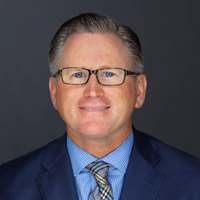Retirees Need to Face the High Cost of Bad Luck
When you're working and the stock market plunges, it's a temporary problem. But if you've just retired, or are about to, then it could devastate your retirement savings. It's called "sequence of returns risk."


It makes me a little nervous when investors talk about “average rates of return” as though those numbers are something you can blithely base much of their retirement income plan on.
In reality, once you start withdrawing money from the nest egg you worked so hard to build, it’s the sequence of those returns, not the averages, that can have a major effect on your wealth.
Down markets are little more than a distraction when you’re young and still adding to your retirement savings. No one likes to see them, but with time — and continuing contributions — you can usually make back your money and then some.
From just $107.88 $24.99 for Kiplinger Personal Finance
Become a smarter, better informed investor. Subscribe from just $107.88 $24.99, plus get up to 4 Special Issues

Sign up for Kiplinger’s Free Newsletters
Profit and prosper with the best of expert advice on investing, taxes, retirement, personal finance and more - straight to your e-mail.
Profit and prosper with the best of expert advice - straight to your e-mail.
If you’re in the first five or so years of retirement when a market downturn happens, though, the loss could be devastating. If the market drops 50%, you’ll need to make a 100% gain just to get back to even … or more, since you’ll likely be drawing money from that account while you’re waiting for the market’s recovery.
Think a 50% drop can’t happen? The U.S. has seen two in the last 15 years: In October 2002, the Nasdaq dropped to as low as 1108.49 — a 78.4% decline from the all-time intraday high of 5132.52 it established in March 2000. On Oct. 9, 2007, the Dow closed at 14,164.43, and by March 5, 2009, it had dropped more than 50% to 6594.44.
The problem, of course, is that the market is unpredictable. There’s no tracking system you can count on to alert you that trouble is coming.
Which means it’s up to you to change your investing mindset from accumulation to preservation before you give up your paycheck and start tapping into your life savings. In the distribution phase, the focus is no longer on what you can earn on your money; it’s about what you can keep. Losses are far more impactful than gains.
And while you don’t have control over the market, and whether it will thrive or dive in the years after you retire, you do have some say over the different asset classes into which you allocate your money.
To try to protect yourself of sequence of returns risk, you simply can’t have all your eggs in the growth basket anymore — which is what most people have when they come to our office, as though life exists in a vacuum and there’s never going to be another market downturn.
You also should talk to your financial adviser about the pecking order of how and when you’re going to take your income. Should you start with your IRA, your Roth or your after-tax money? There is no one-size-fits-all answer.
If you don’t have an adviser and you’re five to 10 years away from retirement, it may be time to get one — someone who can help you draw up a proper plan for your retirement goals. And one of the priorities of that plan should be to position you in a way that reduces the chances that bad timing in the market could harm your future.
Kim Franke-Folstad contributed to this article.
Profit and prosper with the best of Kiplinger's advice on investing, taxes, retirement, personal finance and much more. Delivered daily. Enter your email in the box and click Sign Me Up.

Shane Brosnan is a partner at BML Wealth Management in Irvine, Calif. He has more than 20 years of experience in the financial and insurance industry. Investment Advisory Services offered through Cooper Financial Group, an SEC Registered Investment Advisory firm. BML Wealth Management & Cooper Financial Group are not affiliated. California Insurance License # 0B66858.
-
 AI Stocks Lead Nasdaq's 398-Point Nosedive: Stock Market Today
AI Stocks Lead Nasdaq's 398-Point Nosedive: Stock Market TodayThe major stock market indexes do not yet reflect the bullish tendencies of sector rotation and broadening participation.
-
 Top Tech Gifts to Grab at Walmart Before Christmas
Top Tech Gifts to Grab at Walmart Before ChristmasBig savings on Apple, Bose, HP, Vizio and more while there's still time to shop.
-
 AI Appliances Aren’t Exciting Buyers…Yet
AI Appliances Aren’t Exciting Buyers…YetThe Kiplinger Letter Artificial intelligence is being embedded into all sorts of appliances. Now sellers need to get customers to care about AI-powered laundry.
-
 Quick Question: Are You Planning for a 20-Year Retirement or a 30-Year Retirement?
Quick Question: Are You Planning for a 20-Year Retirement or a 30-Year Retirement?You probably should be planning for a much longer retirement than you are. To avoid running out of retirement savings, you really need to make a plan.
-
 Don't Get Caught by the Medicare Tax Torpedo: A Retirement Expert's Tips to Steer Clear
Don't Get Caught by the Medicare Tax Torpedo: A Retirement Expert's Tips to Steer ClearBetter beware, because if you go even $1 over an important income threshold, your Medicare premiums could rise exponentially due to IRMAA surcharges.
-
 I'm an Insurance Pro: Going Without Life Insurance Is Like Driving Without a Seat Belt Because You Don't Plan to Crash
I'm an Insurance Pro: Going Without Life Insurance Is Like Driving Without a Seat Belt Because You Don't Plan to CrashLife insurance is that boring-but-crucial thing you really need to get now so that your family doesn't have to launch a GoFundMe when you're gone.
-
 I'm a Tax Attorney: These Are the Year-End Tax Moves You Can't Afford to Miss
I'm a Tax Attorney: These Are the Year-End Tax Moves You Can't Afford to MissDon't miss out on this prime time to maximize contributions to your retirement accounts, do Roth conversions and capture investment gains.
-
 I'm an Investment Adviser: This Is the Tax Diversification Strategy You Need for Your Retirement Income
I'm an Investment Adviser: This Is the Tax Diversification Strategy You Need for Your Retirement IncomeSpreading savings across three "tax buckets" — pretax, Roth and taxable — can help give retirees the flexibility to control when and how much taxes they pay.
-
 Could an Annuity Be Your Retirement Safety Net? 4 Key Considerations
Could an Annuity Be Your Retirement Safety Net? 4 Key ConsiderationsMore people are considering annuities to achieve tax-deferred growth and guaranteed income, but deciding if they are right for you depends on these key factors.
-
 I'm a Financial Pro: Older Taxpayers Really Won't Want to Miss Out on This Hefty (Temporary) Tax Break
I'm a Financial Pro: Older Taxpayers Really Won't Want to Miss Out on This Hefty (Temporary) Tax BreakIf you're age 65 or older, you can claim a "bonus" tax deduction of up to $6,000 through 2028 that can be stacked on top of other deductions.
-
 Meet the World's Unluckiest — Not to Mention Entitled — Porch Pirate
Meet the World's Unluckiest — Not to Mention Entitled — Porch PirateThis teen swiped a booby-trapped package that showered him with glitter, and then he hurt his wrist while fleeing. This is why no lawyer will represent him.